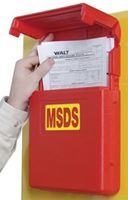| SDS Topics |
Free Sites | FAQ's | Regulations | Glossary | Software | Suppliers |
| Books | Forum | Poll | Fun stuff | Quiz | Store | |
| Advertising slots available. Contact us! | Search ALL our MSDS info | |||||
 |
 |
| SDS Topics |
Free Sites | FAQ's | Regulations | Glossary | Software | Suppliers |
| Books | Forum | Poll | Fun stuff | Quiz | Store | |
| Advertising slots available. Contact us! | Search ALL our MSDS info | |||||
 |
 |
Material Safety Data Sheets (MSDS) is what Safety Data Sheets (SDS) were called before the US Federal agency, OSHA, implemented its version of the Globally Harmonized System of Classification and Labeling of Chemicals (GHS) under the 2012 revision of the OSHA Hazard Communication Standard, 29 CFR 1910.1200 (commonly referred to as the HazCom Standard). In everyday terminology, the two terms are used interchangeably, however, strictly speaking, SDS's have a structured format and required information that MSDS's were not required to have.
Either way, a Safety Data Sheet, SDS, is designed to provide both workers and emergency personnel with the proper procedures for handling or working with a particular substance. SDS's include information such as physical data (melting point, boiling point, flash point etc.), toxicity, health effects, first aid, reactivity, storage, disposal, protective equipment, spill/leak procedures, and more. While SDS's are of particular use if a spill or other accident occurs, they are key to preventing workplace exposure and accidents and should always be consulted before working with a material or developing a new process. In fact, this is how employers generally meet their mandatory employee information and training obligation under the HazCom Standard./
In the US and other countries that use the GHS system, SDS's use a standardized format as well as carefully defined risk phrases, safety phrases, and pictograms to convey their information. These are typically several printed pages longs. In contrast, MSDS's had no required format (they could have been freeform text or haiku as far as OSHA was concerned), no standardized wording, and varied in length, consistency and quality. We have seen them from 1 to 10 pages, with most being 2 to 4 pages.

SDS's are meant for:
SDS's are not meant for consumers. An SDS reflects the hazards of working with the material in an occupational fashion. For example, an SDS for paint is not highly pertinent to someone who uses a can of paint once a year, but is extremely important to someone who uses that paint 40 hours a week. See the question "What are my rights to an SDS?" in the next section of this FAQ for more information.
That said, the Household Products Database by the U.S. National Library of Medicine is a terrific resource for consumers to educate themselves on the hazards of consumer products. For example, use it to select an environmentally-friendly ant killer, to find out who manufacturers a particular product, determine what chemicals are in your shampoo, or figure out what products use xylene!
See also: Manufacturer and employer responsibilities when providing MSDSs electronically for more about employer and manufacturer responsibilities.
Before OSHA implemented its version of the Globally Harmonized System of Classification and Labeling of Chemicals (GHS), MSDS's could be in any format. With the GHS changes, SDS's now have a mandatory 16-part format. Likewise, MSDS's required a more limited amount of information compared to current SDS's. For example, compare the MSDS and SDS for benzoic acid:
See this OSHA Brief "Hazard Communication Standard: Safety Data Sheets" for more information about the currently required 16-part GHS format.
Yes, this OSHA Brief titled "Hazard Communication Standard: Safety Data Sheets" provides a section-by-section explanation of the required information on SDS's under the 2012 revision to the HCS. Some additional resources are:
There are several places you can get them:
Books such as the Merck Index and Prudent Practices in the Laboratory are not acceptable substitutes for SDS's, but these can give practical information on toxicity, physical properties and incompatibles.
[Previous (Index)] [Top of Page] [Next (Regulations)]
Notice: This page is copyright 1998-2025 by ILPI and was last updated Friday, February 23, 2018. Unauthorized duplication or posting on other web sites is expressly prohibited. Disclaimer: The information contained herein is believed to be true and accurate, however ILPI makes no guarantees concerning the veracity of any statement. Use of any information on this page is at the reader's own risk. ILPI strongly encourages the reader to consult the appropriate local, state and federal agencies concerning the matters discussed herein.